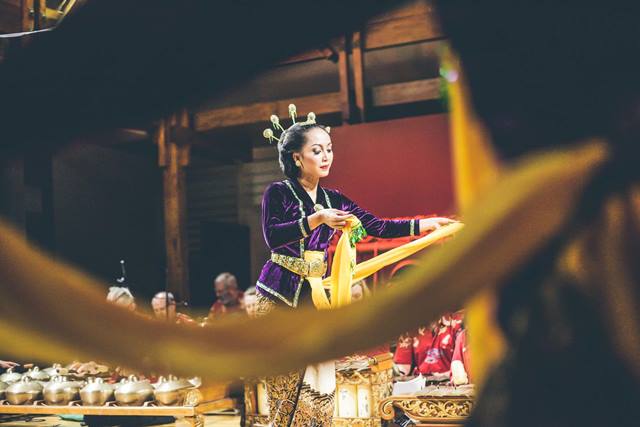5 December 2015, Adam Concert Room, Te Kōkī New Zealand School of Music, Victoria University of Wellington
Reviewed by Jennifer Shennan
Prabhu Sri Bathara Kresna, a character in Indonesian wayang kulit shadow puppet theatre, can wield weapons of supernatural power. One of these, wijaya kusuma, is a flower so beautiful (would that be a lotus, a water lily, or passionfruit flower?), it is said to bring back the dead from their graves.
The director of Gamelan Padhang Moncar, Budi Putra, must have borrowed such a flower for the evening’s performance since Jack Body, loved musician, composer, colleague, mentor and friend, who endeavoured for such a long time to bring this troupe of dancers from Jakarta to New Zealand, died earlier this year so did not live to see their performance. But every member of the capacity audience could sense why he would have wanted to arrange the visit, and their dancing, as beautiful as any lotus, effectively means he came back to spend the evening with us. A miracle.
There are five performers in the visiting troupe, four of them young and sinewy teenagers. Their youth melts away as they begin to dance however, and the quiet authority and mature confidence with which they hold the stage is deeply reassuring. We are not thinking of how they might dance in some years time. They are doing it here and now.
The opening dance of welcome, Sesaji, is an auspicious offering that establishes a mood of serenity for the evening performance. One couple moves as traditional dancers, staying within the highly stylized angularity of etched sculpture that keeps specific emotion disguised, yet still palpably present. The other couple moves in more contemporary style, limbs freer to shape their gestures, to leap, to stretch out into lines that suggest forces of modernity, albeit still carefully measured. The dancers occasionally join in the singing as well. By placing these two generations of styles adjacent and simultaneous, the choreography speaks of past and present not simply by pitching them as alternatives to choose between, but as layers to be absorbed by degrees one into the other. What a civilised and inspired statement about the history of dance.
The second dance, Beksan Enggar-Enggar, depicts a man who has to leave for war saying a reluctant farewell to his wife.

In 2015 as a centennial year from WW I, we have witnessed countless evocations of war and the emotional toll it takes in the lives of ordinary people. Not a one of them would be more poignant than this traditional dance for a couple—who dance so close to each other, yet do not touch, who cast discreet oblique glances as they turn, sway, step, slide, sink and rise to speak their sadness of imminent parting. Their rapport is real, and we sense it will stay strong even when apart. The menuet of French noble dancing from the 18th century court, barely known or understood today other than through its music (think of the adagio movement of Bach’s Double Violin Concerto) shares exactly this same form. When eventually the briefest physical contact is made between the two dancers (he brushes his hand along the back of her waist) the signal of the end of the dance is cast. In this timeless performance by Yani Walundari and Bathara Saverigadi Dewandoro, we saw something that words cannot paraphrase, and should not try to.
Comedy bounded in for the third dance, Bajidor Kahot, when the older member of the troupe, Tri Kadar Nugroho, with a mask-like face of bright pink, and two protruding rabbit teeth, cavorted around in his attempts to imitate the lithe and graceful skills of the younger dancers. With the consummate timing of all best comedians, he succeeded in making a fool of everyone you’ve ever met who tried to persuade you of his handsome and attractive potential. He’s flat on his back, admiring his reflection in the sky, by the time he realises the young couples have escaped far away from his oafish advances.
Balinese dance is one of the most celebrated of world dance traditions. Its shimmering, staccato, deft and unpredicatable dynamics evoke the firefly, the humming bird, the butterfly, the candle flame. To Balinese gamelan now, Taniwha Jaya, directed by Gareth Farr, we see Tari Margapati, a fascinating duo by Chikal Mutiara Diar and Denta Sepdwiansyah Pinandito. In the bebancihan genre, which combines movement from the normally contrasting male and female styles, gender is layered not demarcated. This is a seemingly simple yet subtly presented theme.
In the final dance, Nusantara Indah, several local dancers from the Indonesian community join the visitors. Beguiling sequences move into tableau-like groupings with a final firework of a multi-limbed creature bringing a festive air to the ending of a truly memorable performance.
Throughout the evening the musicians in three gamelan ensembles, as well as Indonesian community playing angklung, rendering Pokarekare ana in Maori, offered affirmation that what is different between people is opportunity for seeing what is shared.
We should treasure the wisdom embedded in the DNA of traditional dances. They are, mostly speaking, an endangered species in the world, but this spirited little troupe, by the calibre of its performance, and its beautiful costuming, is carrying its past into its future.
Jennifer Shennan, 6 December 2015
2 thoughts on “Java Dance. Swargaloka Dance Troupe (from Jakarta), and Gamelan Wellington”